
197 posts
.









Чили.
Остров Пасхи также известен как Рапа-Нуи. Его площадь около 162,5 кв. км.Сам осторов расположен в Тихом океане и привлекает путешественников таинственными каменными истуканами, о происхождении которых ходят различные мифы и легенды.
Статуи острова Пасхи называются моаи — это гигантские фигуры человека, вырезанные из горной породы вулканического происхождения. Высотой больше 10 м, они весят более 150 тонн. Встречаются моаи в виде огромной головы или с туловищем до уровня пояса.Идолы разбросаны по всему острову и часто объединены в группы.
Несмотря на то, что поездка на остров Пасхи довольно дорогое мероприятие, ежегодно сотни тысяч туристов едут в Чили, чтобы своими глазами увидеть этих загадочных великанов, сделать фото с моаи и полюбоваться закатами и восходами.
Chile.
Easter Island is also known as Rapa Nui. Its area is about 162.5 sq. km. The island itself is located in the Pacific Ocean and attracts travelers with mysterious stone idols, about the origin of which there are various myths and legends.
The statues of Easter Island are called moai - these are giant human figures carved from volcanic rock. More than 10 m high, they weigh more than 150 tons. There are moai in the form of a huge head or with a body up to waist level. Idols are scattered throughout the island and are often combined into groups.
Despite the fact that a trip to Easter Island is quite an expensive event, hundreds of thousands of tourists travel to Chile every year to see these mysterious giants with their own eyes, take photos with moai and enjoy sunsets and sunrises.
Источник: Telegram-канал САМЫЕ КРАСИВЫЕ МЕСТА НА ЗЕМЛЕ.
Source: Telegram channel THE MOST BEAUTIFUL PLACES ON EARTH
-
 vlado liked this · 11 months ago
vlado liked this · 11 months ago -
 scooby-doo-exploration liked this · 11 months ago
scooby-doo-exploration liked this · 11 months ago -
 yoda-2691 liked this · 1 year ago
yoda-2691 liked this · 1 year ago -
 saucerkommand liked this · 1 year ago
saucerkommand liked this · 1 year ago -
 aravenlunatic liked this · 1 year ago
aravenlunatic liked this · 1 year ago -
 cernunnos1990 reblogged this · 1 year ago
cernunnos1990 reblogged this · 1 year ago -
 dok-spok liked this · 1 year ago
dok-spok liked this · 1 year ago -
 louiethebaddie liked this · 1 year ago
louiethebaddie liked this · 1 year ago -
 oceaniastuff reblogged this · 1 year ago
oceaniastuff reblogged this · 1 year ago -
 ba-gg liked this · 1 year ago
ba-gg liked this · 1 year ago -
 chuprinin liked this · 1 year ago
chuprinin liked this · 1 year ago -
 firstlawcedarprairie liked this · 1 year ago
firstlawcedarprairie liked this · 1 year ago -
 stevetoppsculpture liked this · 1 year ago
stevetoppsculpture liked this · 1 year ago -
 king-of-roses-world liked this · 1 year ago
king-of-roses-world liked this · 1 year ago -
 foxerto liked this · 1 year ago
foxerto liked this · 1 year ago -
 alissa12 liked this · 1 year ago
alissa12 liked this · 1 year ago -
 universe888 liked this · 1 year ago
universe888 liked this · 1 year ago -
 the-replicant liked this · 1 year ago
the-replicant liked this · 1 year ago -
 dmitriy-rusanov liked this · 1 year ago
dmitriy-rusanov liked this · 1 year ago -
 pacogabby liked this · 1 year ago
pacogabby liked this · 1 year ago -
 vital-deloin liked this · 1 year ago
vital-deloin liked this · 1 year ago -
 magicdreamspoetry liked this · 1 year ago
magicdreamspoetry liked this · 1 year ago -
 behappy4aday liked this · 1 year ago
behappy4aday liked this · 1 year ago -
 fwagnerf liked this · 1 year ago
fwagnerf liked this · 1 year ago -
 maurogata22 reblogged this · 1 year ago
maurogata22 reblogged this · 1 year ago -
 maurogata22 liked this · 1 year ago
maurogata22 liked this · 1 year ago -
 green-eyed-dragon13 liked this · 1 year ago
green-eyed-dragon13 liked this · 1 year ago -
 alwaysgeneralcat liked this · 1 year ago
alwaysgeneralcat liked this · 1 year ago -
 lina-vas-dom liked this · 1 year ago
lina-vas-dom liked this · 1 year ago -
 shysaladpeachdean liked this · 1 year ago
shysaladpeachdean liked this · 1 year ago -
 vuonkhuya liked this · 1 year ago
vuonkhuya liked this · 1 year ago -
 blackmanskryptonites reblogged this · 1 year ago
blackmanskryptonites reblogged this · 1 year ago -
 iamwalrus01 liked this · 1 year ago
iamwalrus01 liked this · 1 year ago -
 ge-h-stoert-hoch-zehn liked this · 1 year ago
ge-h-stoert-hoch-zehn liked this · 1 year ago -
 ramonursemale liked this · 1 year ago
ramonursemale liked this · 1 year ago -
 superpedrostuff reblogged this · 1 year ago
superpedrostuff reblogged this · 1 year ago -
 superpedrostuff liked this · 1 year ago
superpedrostuff liked this · 1 year ago -
 l-amour-grotesque liked this · 1 year ago
l-amour-grotesque liked this · 1 year ago -
 alriks-small-room liked this · 1 year ago
alriks-small-room liked this · 1 year ago -
 koba843 liked this · 1 year ago
koba843 liked this · 1 year ago -
 giulla reblogged this · 1 year ago
giulla reblogged this · 1 year ago -
 ludmila199 liked this · 1 year ago
ludmila199 liked this · 1 year ago -
 deaderrose liked this · 1 year ago
deaderrose liked this · 1 year ago -
 nomordinarie-blog reblogged this · 1 year ago
nomordinarie-blog reblogged this · 1 year ago
More Posts from Vestaignis
Саммеццано — красивейший замок Италии. Sammezzano is the most beautiful castle in Italy.

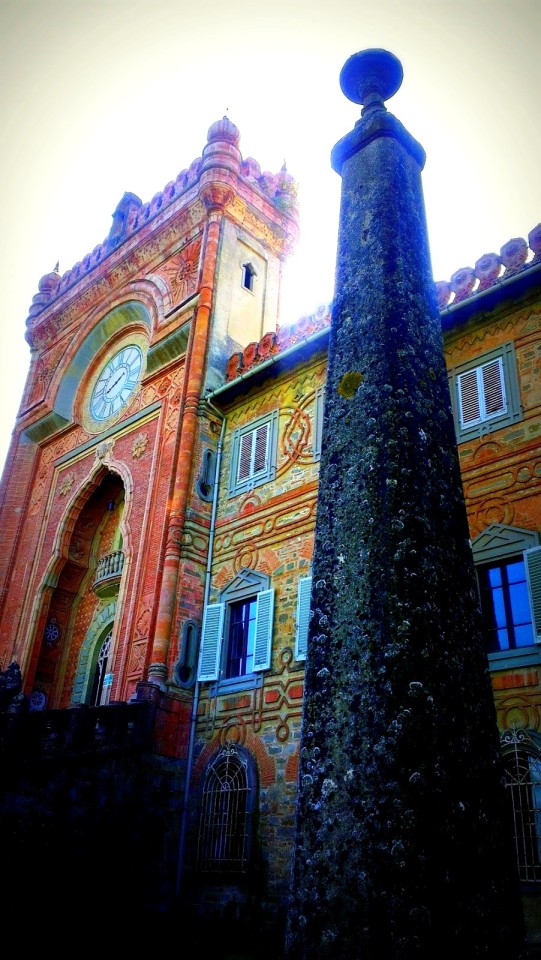




























Замок Саммеццано (Castello di Sammezzano), расположенный в регионе Тоскана, на территории коммуны Реджелло, на окраине Флоренции и рядом с городком Леччио (Leccio) (Италия).Замок был построен в 780 году и за долгое своё существование принадлежал многим знатным семьям.
Имение Саммеццано до 1488 года принадлежало флорентийской семье Гуалтьеротти, затем усадьбой завладели Биндо Альтовити и Джованни де Медичи. В 1564 году великий князь Козимо I установил вето на охоту и ловлю рыбы на обширной территории, прилегающей к замку, а заем преподнес в дар имение своему сыну Фердинанду, будущему великому герцогу Тосканы.
В начале XVII века усадьба была куплена королем Хименеcом Арагонским, а затем в 1816 перешла по наследству к семье Панчиатики в 1816. Именно маркиз Фердинандо Панчиатики Хименес Арагонский между 1853 и 1889 затеял реконструкцию усадьбы в необычный и привлекательный замок, выполненный в мавританском стиле, увлеченный восточным искусством, получившим широкое распространение в Западном Средиземноморье между концом одиннадцатого пятнадцатого века. Если фасад замка Саммеццано напоминает индийский мавзолей Тадж-Махал, то его внутренние украшения навеяны дворцом Альгамбра в Гранаде. Многочисленные и все абсолютно разные залы замка поражают роскошью отделки: среди них выделяются Павлиний зал , Зеркальный зал, зал Лилий, Белый зал и небольшая часовня, поражающие взгляд невероятным сочетанием ярких цветов. Всего замок насчитывает 365 комнат, по одной на один день года.
На сегодня, как ни прискорбно об этом говорить, роскошный замок Саммеццано продолжает пребывать в состоянии заброшенности. Формально замок находится в фазе реставрации, однако фактически работы в замке не ведутся.О нём заботятся волонтёры, и экскурсии в нём проводятся крайне редко.
Sammezzano Castle (Castello di Sammezzano), located in the Tuscany region, in the territory of the commune of Reggello, on the outskirts of Florence and near the town of Leccio (Italy). The castle was built in 780 and over its long existence belonged to many noble families. The Sammezzano estate belonged to the Florentine Gualtierotti family until 1488, then Bindo Altoviti and Giovanni de' Medici took possession of the estate. In 1564, Grand Duke Cosimo I vetoed hunting and fishing in the vast area surrounding the castle, and a loan gifted the estate to his son Ferdinand, the future Grand Duke of Tuscany.
At the beginning of the 17th century, the estate was purchased by King Jimenez of Aragon, and then in 1816 it was inherited by the Panciatici family in 1816. It was the Marquis Ferdinando Panciatici Jimenez of Aragon, between 1853 and 1889, who began the reconstruction of the estate into an unusual and attractive castle, made in the Moorish style, fascinated by the oriental an art that became widespread in the Western Mediterranean between the end of the eleventh and fifteenth centuries.
If the façade of Sammezzano Castle is reminiscent of the Indian mausoleum of the Taj Mahal, its interior decorations are inspired by the Alhambra Palace in Granada. The numerous and all completely different halls of the castle amaze with the luxury of decoration: among them, the Peacock Hall, the Hall of Mirrors, the Hall of Lilies, the White Hall and a small chapel stand out, striking the eye with an incredible combination of bright colors. In total, the castle has 365 rooms, one for each day of the year.
Today, no matter how sad it is to say, the luxurious Sammezzano Castle continues to be abandoned. Formally, the castle is in the restoration phase, but in fact no work is being carried out in the castle. Volunteers take care of it, and excursions are held extremely rarely.
Источник: http://italia-ru.com/page/zamok-sammetstsano-mavritanskii-oazis-serdtse-renessansnoi-toskany,
//tourpedia.ru/sammezzano/,
//italy4.me/toscana/castello-di-sammezzano.html,,
//zagge.ru/sammeccano-krasivejshij-zamok-italii/,
www.mirkrasiv.ru/articles/zamok-samecano-castello-di-sammezzano-toskana-italija.html/
ХУДОЖНИК CESAR AYLLÓN
ARTIST CESAR AYLLÓN


Mis barquitos / oil on canvas / 100 x 80 cm. / year of creation 2020

Eva / oil on canvas / 100 x 100 cm. /year of creation 2020

Mi nube / oil on canvas / 120 cm x 80 cm. / year of creation 2019
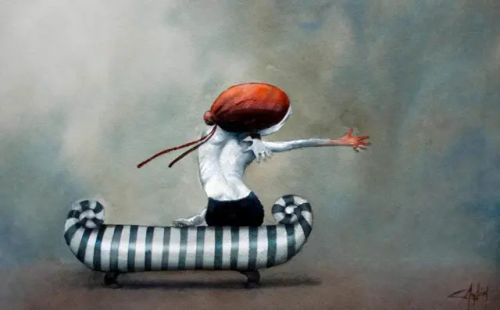
Inalcanzable / oil on canvas / 180 x 80 cm. /year of creation 2019

Jaula / oil on canvas / 100 x 80 cm. / year of creation 2019

Sueños de Otoño / oil on canvas / 120 x 100 cm. / year of creation 2020

La niña del espejo / oil on canvas

AMAPOLA / oil on canvas /100x80 cm/(2023)

TARDE DE OTOÑO / oil on canvas /120x100 cm/ (2023)

LA VIAJERA/ oil on canvas /70x50cm/ (2021)









Сезар Айллон — современный перуанский художник. В своих картинах он выходит за рамки очевидного, чтобы обнаружить символизм в человеческом аспекте повседневной жизни. Идея Айллон состоит в том, чтобы изобразить сказочный мир с помощью шутовских, одиноких, созерцательных и в определенной степени драматичных персонажей.
Сезар Айллон родился в 1959 году в Перу, где изучал пластические искусства на художественном факультете Папского католического университета Перу и в мастерской рисования Кристины Гальвес.
Cesar Aillon is a contemporary Peruvian artist. In his paintings, he goes beyond the obvious to discover symbolism in the human aspect of everyday life. Ayllon's idea is to depict a fairy-tale world with characters who are clownish, solitary, contemplative and somewhat dramatic. Cesar Aillon was born in 1959 in Peru, where he studied plastic arts at the Faculty of Art of the Pontifical Catholic University of Peru and in the drawing workshop of Cristina Galvez.
Источник:https://www.artmajeur.com/cesar-ayllon?view=grid&collections%5B%5D=1541014,
//art.kunstmatrix.com/en/artist/cesar-ayllon,
//www.liveinternet.ru/users/4262933/post501300470/,
//gallery.edgeofhumanity.com/portfolio/cesar-ayllon/
Руины санатория «Гульрипш» Николая Николаевича Смецкого. Абхазия.











Красный корпус


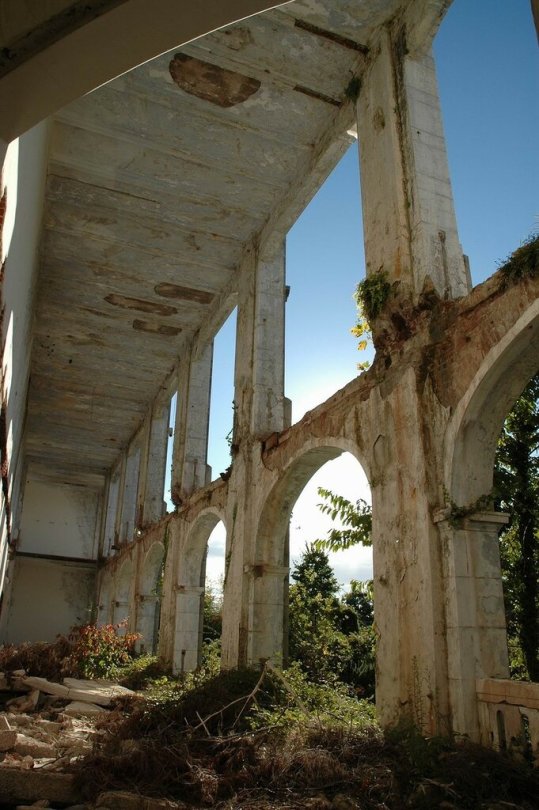
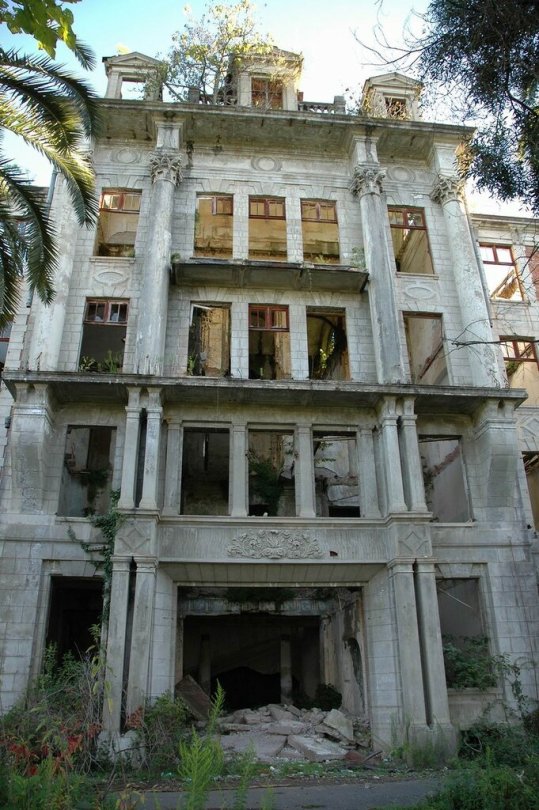




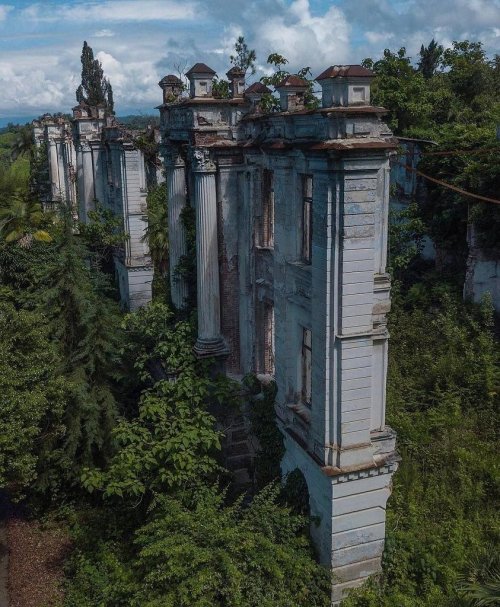
Белый корпус Руины двух корпусов туберкулезного санатория «Гульрипш» дореволюционной постройки находятся недалеко от автодороги в 10 км к юго-востоку от Сухума.
В 1913 г. Смецким был построен четырёхэтажный Красный корпус из 112 комнат на 250 мест. На то время это здание было самым большим в Абхазии. Рядом был устроен огромный сад, где росли кокосы, агавы, акации. Про это здание существует забавная легенда. Якобы жена Смецкого сама была больна туберкулезом, и от одного врача он услышал совет: сделайте так, чтобы каждую ночь она спала на новом месте, где воздух чист от бацилл. Для этого и был построен дом-дворец из 365 комнат, который помог женщине выздороветь.В 1914 году Смецкий передал Красный корпус Красному Кресту для лечения инвалидов войны. Белый корпус в 1916 году был передан Министерству просвещения для лечения учителей и учащихся. В 1922 году дворцы национализировали и устроили в них санаторий имени Ленина.
Ruins of the sanatorium "Gulripsh" of Nikolai Nikolaevich Smetsky.
The ruins of two pre-revolutionary buildings of the Gulripsh tuberculosis sanatorium are located near the highway 10 km southeast of Sukhum. In 1913, Smetsky built a four-story Red building of 112 rooms with 250 seats. At that time this building was the largest in Abkhazia. Nearby there was a huge garden where coconuts, agaves, and acacias grew. There is a funny legend about this building. Allegedly, Smetsky’s wife herself was sick with tuberculosis, and from one doctor he heard advice: make sure that every night she sleeps in a new place where the air is clear of bacilli. For this purpose, a house-palace of 365 rooms was built, which helped the woman recover.
In 1914, Smetsky donated the Red Corps to the Red Cross for the treatment of war invalids. The White Building was transferred to the Ministry of Education in 1916 for the treatment of teachers and students. In 1922, the palaces were nationalized and a sanatorium named after Lenin was built in them.
Вот как эти строения выглядели раньше, архивные фото.
This is what these ruins looked like before, archival photos.





Источник : :https://ru-abandoned.livejournal.com/1690647.html
//idei.club/raznoe/10915-dvorec-smeckogo-v-abhazii.html.
//yarkolp.livejournal.com/4799.html
//dzen.ru/a/YGcj4mCNXCBzoNEt?utm_referer=www.google.com
glebzverev.ru/abkhazia/sukhum-sanatoriy-smetskogo.htm
Ян ван Кессель Старший (нидерл. Jan van Kessel; 1626—1679) Jan van Kessel the Elder

INSECTS, MUSSELS, AND BUTTERFLIES 1659. Oil on copper.

Study of Butterfly and Insects 1655

Insects with Creeping Thistle and Borage

Insects with Common Hawthorn and Forget-Me-Not


Insects

A Dragon-fly, two Moths, a Spider and some Beetles, with wild Strawberries

Insects and a Sprig of Rosemary, 1653, oil on panel.

A Study of Butterflies, Moths, Spiders, and Insects

Study of Insects, 1660

Insects

Butterflies and other insects, 1661


Insects

Butterflies and other insects, 1661.
Ян ван Кессель Старший родился в Антверпене и принадлежал к династии знаменитых художников. Его дедушкой был Ян Брейгель Старший , а Давид Тенирс Младший приходился ему дядей. Он был учеником художника-историка Симона де Воса , но, по-видимому, его также обучал его дядя Ян Брейгель Младший (1601–1678).
Ван Кессель присоединился к антверпенской гильдии Святого Луки в 1645 году и специализировался на цветочных натюрмортах , тщательных исследованиях насекомых и аллегорических сериях, представляющих четыре элемента, чувства или части света.
Born in Antwerp, Jan van Kessel the Elder belonged to a dynasty of famous painters. His grandfather was Jan Brueghel the Elder, and David Teniers the Younger was his uncle. He was a pupil of the history painter Simon de Vos, but was apparently also instructed by his uncle Jan Brueghel the Younger (1601–1678).
Van Kessel joined the Antwerp guild of Saint Luke in 1645 and specialised in flower still lifes, meticulous studies of insects, and allegorical series representing the four elements, the senses, or the parts of the world.
Источник://www.nationalgallery.org.uk/artists/jan-van-kessel-the-elder,
www.lempertz.com/en/catalogues/artist-index/detail/kessel-the-elder-jan-van.html,
/artuk.org/discover/artists/van-kessel-the-elder-jan-16261679,
//www.nationalgalleries.org/art-and-artists/artists/jan-van-kessel,
//commons.wikimedia.org/wiki/Paintings_by_Jan_van_Kessel_the_Elder,
//www.nga.gov/collection/art-object-page.216025.html
